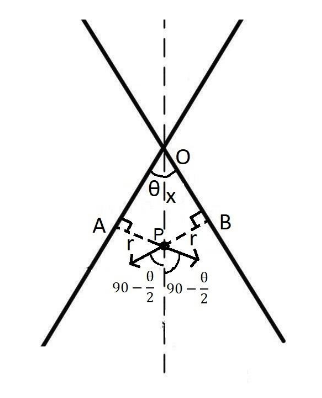
Answer
429.9k+ views
Hint: The basic physical property of matter that causes it to experience a force when kept in an electric or magnetic field is electrical charge. An electric charge is correlated with an electric field and a magnetic field is generated by the moving electric charge. The electromagnetic field is recognized as a combination of electrical and magnetic fields.
Formula Used: We will use the following formula:
$ E = \dfrac{{2k\lambda }}{r} $
Where
$ E $ is the electrical charge
$ \lambda $ is the linear charge density
$ r $ is perpendicular distance of the point from the line charge
$ k $ is the Coulomb’s constant.
Complete step by step solution:
Let us consider an infinitely long line charge whose linear charge density is $ \lambda $
So, the magnitude of the electric field at any point at a distance of $ r $ units will be
$ E = \dfrac{{2k\lambda }}{r} $
And the direction of this electric field will be away from the wire

According to the question, it is given that $ OP = x $
Let us assume that the length $ AP = PB = r $
Now according to the figure,
$ x\sin \dfrac{\theta }{2} = r $
Now we know that
$ E = \dfrac{{2k\lambda }}{r} $
Now, we will replace the value of $ r $ from the above expression. So, we will get
$ E = \dfrac{{2k\lambda }}{{x\sin \dfrac{\theta }{2}}} $
So, the net electrical charge will be
$ {E_{net}} = 2E\sin \dfrac{\theta }{2} $
$ = 2\left( {\dfrac{{2k\lambda }}{{x\sin \dfrac{\theta }{2}}}} \right) \times \sin \dfrac{\theta }{2} $
Therefore, the magnitude of the net electrical charge will be
$ {E_{net}} = \dfrac{{4k\lambda }}{x} $
And the direction of this net charge will be along $ OP $ .
Note:
An electrical charge is a scalar quantity. In addition to having a magnitude and direction, the laws of vector addition such as triangle law of vector addition and parallelogram law of vector addition should also obey a quantity to be called a vector, only then is the quantity said to be a quantity of vector. When two currents meet at a junction, in the case of an electric current, the resulting current will be an algebraic sum and not the sum of the vector. Therefore, a scalar quantity is an electric current, although it has magnitude and direction.
Formula Used: We will use the following formula:
$ E = \dfrac{{2k\lambda }}{r} $
Where
$ E $ is the electrical charge
$ \lambda $ is the linear charge density
$ r $ is perpendicular distance of the point from the line charge
$ k $ is the Coulomb’s constant.
Complete step by step solution:
Let us consider an infinitely long line charge whose linear charge density is $ \lambda $
So, the magnitude of the electric field at any point at a distance of $ r $ units will be
$ E = \dfrac{{2k\lambda }}{r} $
And the direction of this electric field will be away from the wire

According to the question, it is given that $ OP = x $
Let us assume that the length $ AP = PB = r $
Now according to the figure,
$ x\sin \dfrac{\theta }{2} = r $
Now we know that
$ E = \dfrac{{2k\lambda }}{r} $
Now, we will replace the value of $ r $ from the above expression. So, we will get
$ E = \dfrac{{2k\lambda }}{{x\sin \dfrac{\theta }{2}}} $
So, the net electrical charge will be
$ {E_{net}} = 2E\sin \dfrac{\theta }{2} $
$ = 2\left( {\dfrac{{2k\lambda }}{{x\sin \dfrac{\theta }{2}}}} \right) \times \sin \dfrac{\theta }{2} $
Therefore, the magnitude of the net electrical charge will be
$ {E_{net}} = \dfrac{{4k\lambda }}{x} $
And the direction of this net charge will be along $ OP $ .
Note:
An electrical charge is a scalar quantity. In addition to having a magnitude and direction, the laws of vector addition such as triangle law of vector addition and parallelogram law of vector addition should also obey a quantity to be called a vector, only then is the quantity said to be a quantity of vector. When two currents meet at a junction, in the case of an electric current, the resulting current will be an algebraic sum and not the sum of the vector. Therefore, a scalar quantity is an electric current, although it has magnitude and direction.
Recently Updated Pages
Fill in the blanks with suitable prepositions Break class 10 english CBSE

Fill in the blanks with suitable articles Tribune is class 10 english CBSE

Rearrange the following words and phrases to form a class 10 english CBSE

Select the opposite of the given word Permit aGive class 10 english CBSE

Fill in the blank with the most appropriate option class 10 english CBSE

Some places have oneline notices Which option is a class 10 english CBSE

Trending doubts
Fill the blanks with the suitable prepositions 1 The class 9 english CBSE

How do you graph the function fx 4x class 9 maths CBSE

When was Karauli Praja Mandal established 11934 21936 class 10 social science CBSE

Which are the Top 10 Largest Countries of the World?

What is the definite integral of zero a constant b class 12 maths CBSE

Why is steel more elastic than rubber class 11 physics CBSE

Distinguish between the following Ferrous and nonferrous class 9 social science CBSE

The Equation xxx + 2 is Satisfied when x is Equal to Class 10 Maths

Differentiate between homogeneous and heterogeneous class 12 chemistry CBSE





